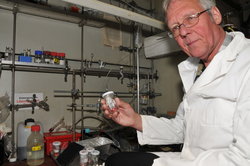TUHH scientist traces what for dogs is the strong scent of cancer cells
07.10.2013

Foto: TUHH/Martina Brinkmann
The theory is currently being discussed by an expert commission as peer-review of a highly respected scientific Journal.
Dogs have long been known to be able to distinguish different kinds of tumour from human breath or urine and to do so surely and at an early stage. With their extremely sensitive noses they can identify a single scent molecule among a trillion others. Science has yet to come up with analytical procedures powerful enough to provide in the foreseeable future an electronic replacement for the canine sense of smell. But there is progress to report. Dr. rer. nat. Wolfgang Schröder of the Hamburg University of Technology (TUHH) has made a significant step forward toward answering the question which substances and in which concentration are the reason why cancer cells smell differently from healthy cells. "I have found substances, you can call them chemical markers," he says, "that seem to be the smell of cancer."
He holds in his hand a small bottle filled with a red liquid. "The substances that I have synthesized are highly photogenic; they are ruby red," he says. "The liquid alone looks almost mysterious but has an overpoweringly putrid smell." Dr. Schröder, a chemist and senior engineer at the TUHH’s Institute of Measurement Technology, realised from the outset that the odours tumours emit must be strong and of interest to dogs. "Otherwise," he says, "the animals would not react as noticeably as they do."
The TUHH scientist has for ten years been engaged in research to trace and identify the cancer scent markers that for dogs have such a strong smell. That is anything but child’s play as human breath contains well over a thousand different substances that have to be analysed and evaluated. Using samples from Kiel University Hospital the chemist has analysed in recent years hundreds of breath samples taken from patients with a wide range of diseases, including cancer. Odour-active substances have been identified, but no significant difference between the breath of cancer patients and healthy people could be found. Further research on the natural malodorous substances in human breath - substances that Dr. Schröder had never lost sight of - revealed the image of a substance family that is highly reactive and therefore tends to create derived products in the course of preparing and analysing samples. Detailed study of the copious current literature on chemism in cancer finally led the TUHH research scientist to a hot track. A specific member of this malodorous substance family must always be present in cancer (and only in cancer). But it proved after synthesis in the TUHH Institute of Measurement Technology’s laboratory to be far too unstable to be identified by conventional means.
They were eventually stabilised and identified in a high concentration in extremely gentle conditions in a specially optimised low-temperature gas chromatograph. But there was no question of identifying them in a low concentration as suspected in cancer cases.
It was collaboration with sniffer dog trainers Uwe Friedrich and Nicole Klee of TeamCanin in southern Germany that achieved the breakthrough. A dog was trained to identify the synthetic mixture of substances suspected of being cancer markers. Extremely small quantities of odorous substances were used, released by a diffusion tube. After weeks of almost daily training the dog was able to safely spot these substances among mixtures that were "unsuspicious". The time had then come. Without appearing to change anything, the dog suddenly had five samples of human liver tissue and a liver tumour in its covered sniffer boxes. Without hesitation the cancer sample was identified even though the dog had never yet smelt cancer - apart from Dr. Schröder’s markers. Further experiments of this kind with anonymised test samples confirmed the result.
The findings are currently being discussed by an expert commission as peer-review of a highly respected scientific Journal. The main features of this new theory of cancer markers are as well planned to be published as an overview article in a journal that addresses new hypotheses in medicine to start the scientific debate.
The TUHH scientist’s results can be summarised as follows. New cancer markers can be derived from the chemism that is already known to occur in diseased tissue. Dogs confirm that the synthetic substances smell of cancer. In diluted solutions they are sufficiently stable under exclusion of air to smell even after weeks have elapsed. But their concentration in cancer tissue is far too low to prove their existence by means of analysis. That is largely due to their instability, which may also be regarded as a reason why nobody has yet suggested that substances of this kind could be cancer markers, let alone been able to identify them in tumours. Work is in progress on whether the findings are as clear with other kinds of cancer tumour as with liver tumours. The sniffer dogs will be called in again. One day cancer should eventually be identifiable in few seconds using electronic odour detectors. "A great deal of what is sure to be very interesting work still lies ahead," says a delighted Dr. Schröder.
Contact:
Dr. rer. nat. Wolfgang Schröder
Hamburg University of Technology
Institute of Measurement Technology
Harburger Schlossstr. 20
21079 Hamburg
Germany
Tel.: +49 40 428 78 22 39
E-mail: w.schroeder@tuhh.de
Home page: http://www.tuhh.de/mt/mit … r/wolfgang-schroeder.html
TUHH - Public Relations Office
Martina Brinkmann
E-Mail: pressestelle@tuhh.de







